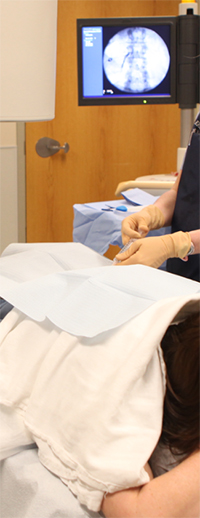 Injection Therapy
Injection Therapy
The philosophy of the spine care team at Spine Center Network is that many patients in our experience will get better with rest, medication or injections that reduces inflammation, core strengthening and spine-specialized physical therapy programs.
 Injection therapy is intended to be a means to an end. The goal is to provide the patient with enough pain relief to bridge from inactivity to physical therapy, where back problems can be better treated with special stretches and exercises.
Injection therapy is intended to be a means to an end. The goal is to provide the patient with enough pain relief to bridge from inactivity to physical therapy, where back problems can be better treated with special stretches and exercises.
If you haven’t tried non-surgical treatment options, you are likely pursuing a surgical path perhaps unnecessarily. In the field of spine, specialists use cortisone injections, epidural steroid injections, trigger point injections and nerve blocks to relieve pain in the spine.
Philosophically, Spine Center Network has a conservative approach to the care of his patients and encourages non-surgical treatment first. This is in contrast to many other spine surgeons who may be biased toward spine surgery because of their limited experience with non-surgical treatment options.
Spine Center Network refers patients to specialists who are proficient in spinal injections.
When those non-surgical options fail, or if there are emergency symptoms, then minimally invasive spine surgery is the next treatment option to explore.
Injections can be both therapeutic AND diagnostic
At Spine Center Network, the use of injection therapy accomplishes two very important functions.
THERAPEUTIC FUNCTION: The first purpose of the spinal injection is to provide a therapeutic benefit to the patient, that is, relief of pain symptoms, or relief of the weakness or numbness in the leg or arm caused by a herniated disc.
DIAGNOSTIC FUNCTION: The second function is to reveal important diagnostic information to the spine specialist. For instance, if the injection of medication near the nerve root at a certain level of the spine FAILS TO RELIEVE the pain symptom or the weakness caused by the impinged nerve, the spine surgeon learns something very important. One possibility is that the symptoms are coming from a different disc at a different level. This is key, because without this information, a surgeon could operate and remove disc tissue at a level that appears on an MRI to have a herniation, but in fact that herniation is NOT the cause of the patient’s symptoms.
Injections can ensure a successful surgery
Is is possible to be misled by an MRI that shows a disc herniation? Absolutely. Research studies have shown that about 40% of healthy people over age 40, with no back pain whatsoever, can have disc problems that would show up on an MRI.
Said another way, a herniated disc that appears on an MRI scan does not necessarily have to be the cause of one’s pain symptoms. It could be something else, like a disc problem at another level, an arthritic facet joint, a narrowing of the spinal canal (called stenosis) or other issue.
Injection therapy when done prudently, and not in a repetitious manner, can ensure that if surgery is necessary, the right surgery would be performed on the real problem.
If your surgeon did not explore injections, you could be having an unnecessary surgery, or a surgery at the wrong level
There are two worst-care scenarios that injection therapy is designed to prevent:
Prevent a person from having a surgery that wasn’t necessary in the first place.
Prevent a surgeon from operating on the wrong disc.
In conclusion, if your spine specialist doesn’t at least consider the role of injection therapy in your assessment and treatment, you may be at risk for one of the two worst-case scenarios.
[Top]
